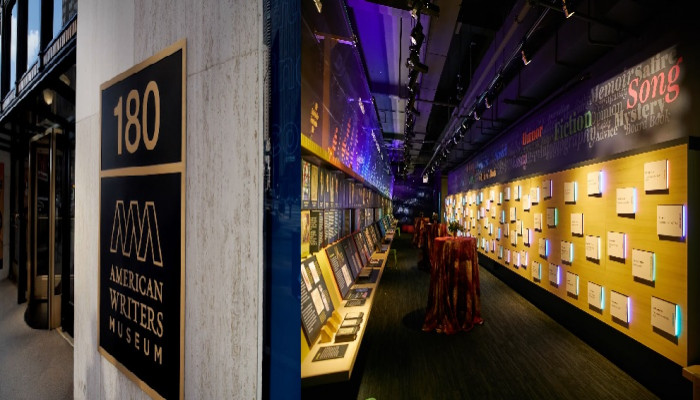The American Writers Museum: Redefining the Museum Experience
- In Travel
- 11:52 AM, Jul 18, 2025
- Richa Yadav
If you are a Hindi reader, you might have read magazines like Dharmyug, Saptahik Hindustan, Kadambini, Nandan, Chandamama, etc. while growing up, or at least heard of popular Hindi fiction novels like ‘Aapka Bunti’ ‘Jahaj ka panchi’ and ‘Suraj ka satwan ghoda’. As a part of the school curriculum, students in Northern states are taught about how Hindi authors and poets have significantly shaped India's literary and cultural landscape, contributing through their prolific works exploring themes like social, humanitarian, political and nationalism. Key figures like Bharatendu Harishchandra, Mahadevi Varma, Jaishankar Prasad and many more have left a lasting impact on Hindi literature through their novels, poetry, and plays.
Unfortunately, these narratives remain confined to school curricula. With time, the accessibility and availability of this vast corpus of literature are becoming difficult. Most of these magazines and books are either out of print or are difficult to find in any bookstore, specifically in less developed cities. It is challenging to find a library or shop in India that stocks the entire range. It's alarming how quickly the works of these significant writers are fading into obscurity, swiftly being substituted by the monstrous wings of social media.
While it is not necessary to read each of the master pieces of one’s native literature, knowing the stories from different times in history helps us understand how the hues and shades of history are shaped by the power of writing on society; how, at times pen could have a lasting impression when swords failed!
However, in the modern world, if the stereotype that the East is notorious for copying the West is true, I hope someday soon someone will think about copying the wonder I experienced recently.
America consistently transforms simple concepts into something grand, glamorous, and talk-of-the-town, be it simple potato fries, burger buns, blue jeans, or its leadership. It knows how to draw the world’s attention and become the centre of attraction. While walking on the streets of downtown Chicago, Illinois, I stumbled upon an unassuming, relatively small, barely noticeable building known as the “American Writers Museum”. I had a spare hour, so I bought the ticket and thought of spending some time there, but little did I know what I was signing up for! My next three hours were filled with emotion, elation, and nostalgia learning about a few known and hundreds of unknown American writers in an interesting setup!
This immersive and interactive museum, based on American writers, presents their work and history from the last 400 years in a mesmerising way. If one has an interest in reading and writing, one can remain engrossed in the material for more than three hours. The museum engages the visitors to use all of their five senses to explore the long and deep tunnel of the art of story writing, well-known writers, and their unforgettable works that have together contributed to ‘make America great’.
This museum, founded in 2017, was inspired by the thought that there was no such thing that brought all the writers of the country together and recognised them by appreciating their work and opening it to a larger audience. A content leadership team was identified along with subject matter experts, writers, poets, editors, and scholars who collectively envisaged the unusual form and function of this museum.
The museum approaches visitors in myriad ways: by touch screen exhibits, informative murals, banner displays, recorded voices, smells of food, painted and digital visuals, posters, and over a hundred free takeaway bookmarks with relevant information about the writers. There are huge digital display boards where visitors can grab an icon and pull it down so that it will open a small website with large amounts of information on that one particular work, the author’s bio and other works on a specific theme.
Visitors can step back in time with the museum’s impressive wall display, chronologically featuring writers from the 1500s to the 1900s. Each entry provides a brief biography and highlights the work of authors whose written contributions were instrumental in shaping American history or who played a direct role in significant historical events. The content spans from America's colonisation through the periods of independence and beyond, extending into the modernist era.
The wall opposite the one mentioned above is just as interesting. There are about hundred revolving panels mounted on the wall; on one side it mentions the name of the author, his or her main work, genre, and on the other side displays something interesting about the authors, a sample of their writing, a sample of a famous speech if it's a leader, a short poem, or even a sample of some food smell if its a panel for a food writer! This long list of about a hundred writers includes songwriters, travel writers, feminist and Black writers, literary critics, comic strip writers, and comedians. Interestingly, I spotted Dhan Gopal Mukerji on the wall, who was an influential Indian-American writer. These writers together are illustrative of the idea of creating an American voice.
There is a separate room dedicated to children's literature. It invites kids to check the beautiful mural of a tree with 32 squirrels sitting on different branches of the tree. Check out Squirrels Who Read Offers Books & Indoor Activities for Kids - Favourite Kids Books - The American Writers Museum. Each squirrel will have something unique, hinting at a book that kids or even adults can guess along with the name of the writer of the book. For example, if you look at the main branch on the right, starting from the trunk, you can see a squirrel reading a blue book that hints at the actual blue collection by Mark Twain. The Adventures of Tom Sawyer | Mark Twain, Samuel L. Clemens | First edition
The best thing about the museum is that it does not rank the writers or give more importance to one writer over another. It only highlights how the writers have contributed to the shaping of ‘American voice’, not who was more successful or more popular in their journey.
The museum is quite educationally focused to give a comprehensive view of the entire community of writers covering some 500 years of the nation’s history. There is a separate section about immigrant writers. Here, people can grab a luggage tag and tell their family's immigrant story or their own immigrant story by writing a few lines.
There is a reader's hall where people can come and sit on a couch, grab a book off the shelf, and enjoy reading. Another section called ‘share your character’ encourages the readers to share if they have any weird, unique character in mind. There is a whole section on creating games that covers a lot about some video game writers in America.
‘Writers room’ certainly deserves a mention. Here, the visitors can see a collection of writing artefacts, some old functional typewriters for people to sit and type their own story.
In a nutshell, not only books but also the voices and their impact should be conveyed meaningfully, as they cannot visually speak for themselves like a picture. Each master piece needs a boisterous storyteller to convey its messages. Visiting this museum, I can just deeply wish that one day such a museum will be created for more Indian languages in India with such fantastic features and incredibly interactive exhibits for readers and writers of all ages. This will not only help us keep our rich literary tradition alive but will also encourage our youngsters to find their motivation to write in the time to come.
Disclaimer: The opinions expressed within this article are the personal opinions of the author. MyIndMakers is not responsible for the accuracy, completeness, suitability, or validity of any information on this article. All information is provided on an as-is basis. The information, facts or opinions appearing in the article do not reflect the views of MyindMakers and it does not assume any responsibility or liability for the same.







Comments